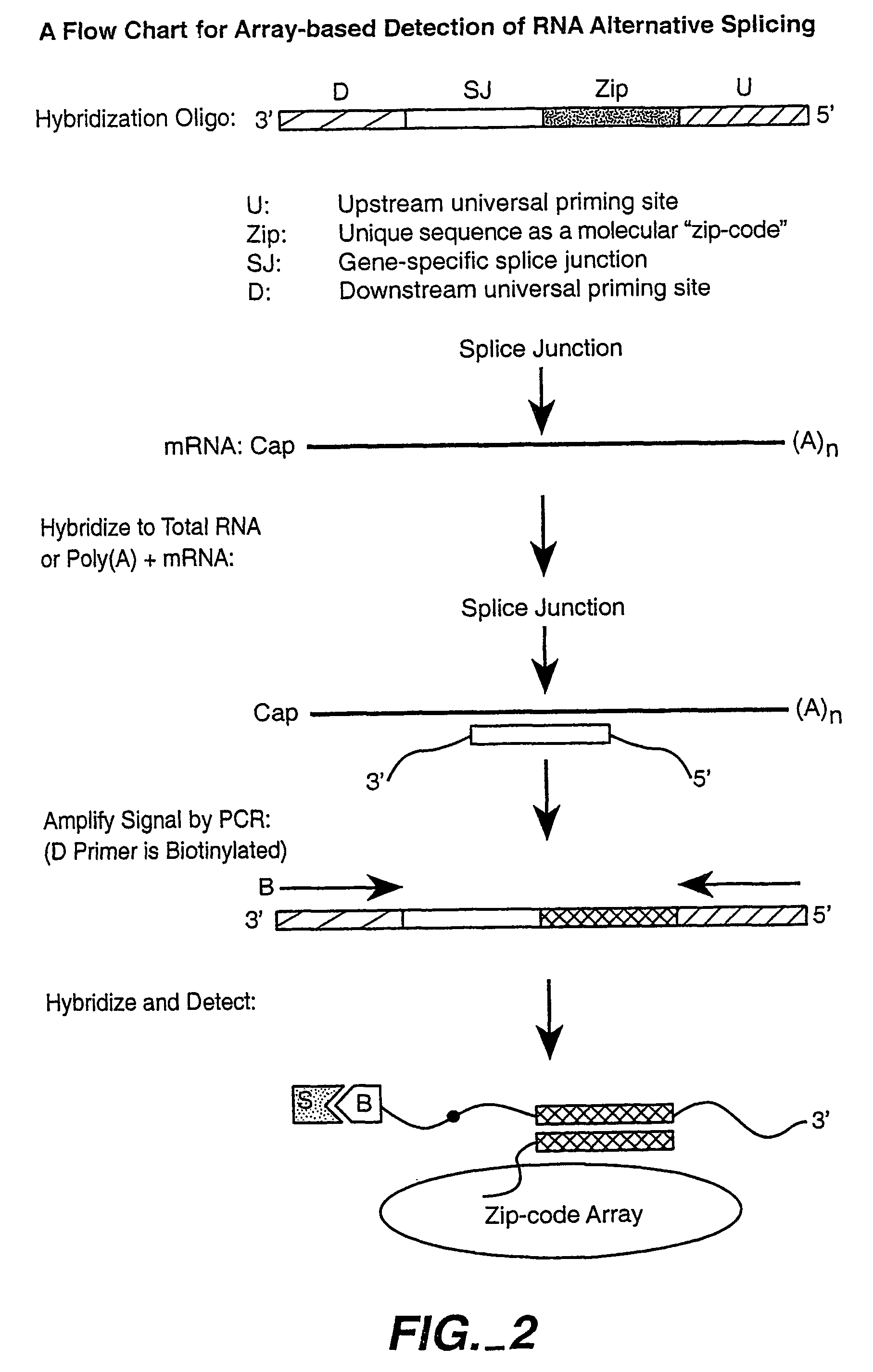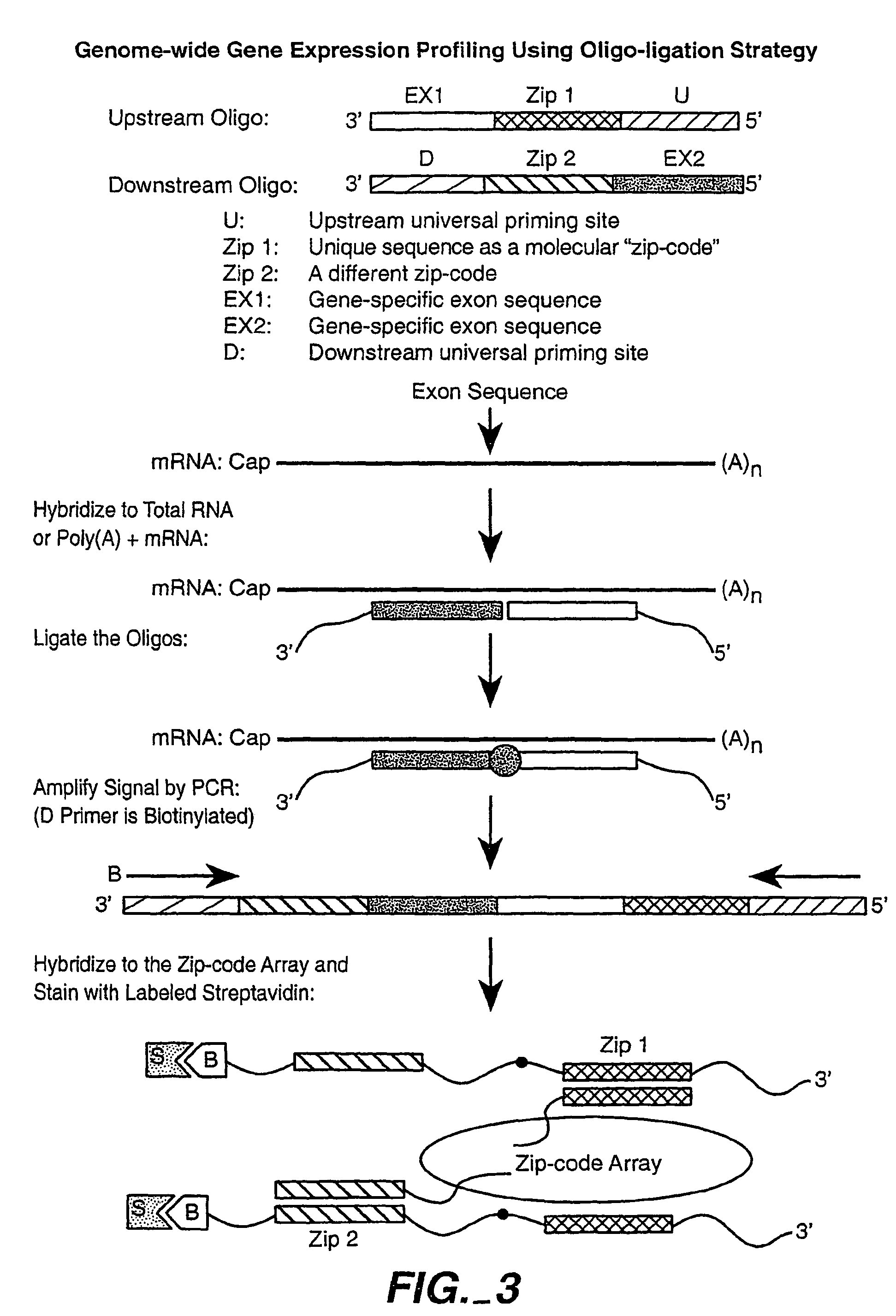Multiplexed methylation detection methods
a detection method and complex technology, applied in the field of multiplexed assays for target analytes, can solve the problems of inability to detect multiple targets simultaneously, limited detection of multiple proteins, etc., and achieve the effect of higher affinity and higher affinity
- Summary
- Abstract
- Description
- Claims
- Application Information
AI Technical Summary
Benefits of technology
Problems solved by technology
Method used
Image
Examples
example 1
Attachment of Genomic DNA to a Solid Support
1. Fragmentation of Genomic DNA
[0298]
Human Genomic DNA10_g (100 μl)10× DNase I Buffer12.5μlDNase I (1 U / _μl, BRL)0.5μlddH2O12μl
Incubate 37° C. for 10 min. Add 1.25 μl 0.5 M EDTA, Heat at 99° C. for 15 min.
2. Precipitation of Fragmented Genomic DNA
[0299]
DNase I fragmented genomic DNA125 μlQuick-Precip Plus Solution (Edge Biosystems) 20 μlCold 100% EtOH300 μl
Store at −20° C. for 20 min. Spin at 12,500 rpm for 5 min. Wash pellet 2× with 70% EtOH, and air dry.
3. Terminal Transferase End-Labeling with Biotin
[0300]
DNase I fragmented and precipitated genomic DNA (in H2O)77.3μl5× Terminal transferase buffer20μlBiotin-N6-ddATP (1 mM, NEN)1μlTerminal transferase (15 U / μl)1.7μl
37° C. for 60 min. Add 1 μl 0.5 M EDTA, then heat at 99° C. for 15 min
4. Precipitation of Biotin-Labeled Genomic DNA
[0301]
Biotin-labeled genomic DNA100 μlQuick-Precip Solution 20 μlEtOH250 μl
−20° C. for 20 min and spin at 12,500 rpm for 5 min, wash 2× with 70% EtOH and air dry....
example 2
Methylation Detection Assays
[0320]Plasmid DNA was used as an independent control DNA. The quality of methylation was tested by restriction digest of umnethylated and methylated DNA by methylation sensitive enzyme Hpa II and its isoschisomer Msp I, which is not sensitive to methylation. Bands were not detected on an agarose gel after digestion with methylated pUC19 with Hpa II for two hours at 37° C., while the unmethylated DNA was completely digested (data not shown).
[0321]A set of OLA primers targeted to 5 different Hpa II sites on the pBluescript KS+ plasmid were designed. Four out of these 5 sites are also present on pUC19. The specificity of these primers was tested in a model experiment using a standard genotyping protocol on the bead array. Methylated or unmethylated plasmid DNA was spiked into a human genomic DNA sample at approximately 1:1 molar ratio (1 pg of plasmid DNA to 1 ug of human genomic DNA). Samples were digested by restriction enzymes Dra I or Dra I in combinatio...
example 3
Whole Genome Amplification of Bi-Sulfite Converted Genomic DNA
[0322]Using standard DNA polymerase, this approach takes advantage of the unique sequence feature of genomic DNAs after bisulfite treatment, i.e. all the un-methylated cytosines are converted to uracil. Therefore, the DNA template for amplification will only contain three bases, A, G and T, and will be single-stranded, as opposed to the regular gDNA template.
[0323]Genomic amplification can be performed with a mixture of two sets of primers that contain all possible combinations of three nucleotides, in particular a first set having A, T and C, but not G; and a second set having A, T and G, but not C. Primers from the first set will have higher affinity to the original bisulfite converted DNA strand, while primers from the second set will preferentially anneal to the newly synthesized complementary strand. This approach avoids the presence of G and C in the same primer, thus preventing the primers to cross over any CpG sit...
PUM
| Property | Measurement | Unit |
|---|---|---|
| temperature | aaaaa | aaaaa |
| Tm | aaaaa | aaaaa |
| pH | aaaaa | aaaaa |
Abstract
Description
Claims
Application Information
 Login to View More
Login to View More - R&D
- Intellectual Property
- Life Sciences
- Materials
- Tech Scout
- Unparalleled Data Quality
- Higher Quality Content
- 60% Fewer Hallucinations
Browse by: Latest US Patents, China's latest patents, Technical Efficacy Thesaurus, Application Domain, Technology Topic, Popular Technical Reports.
© 2025 PatSnap. All rights reserved.Legal|Privacy policy|Modern Slavery Act Transparency Statement|Sitemap|About US| Contact US: help@patsnap.com



